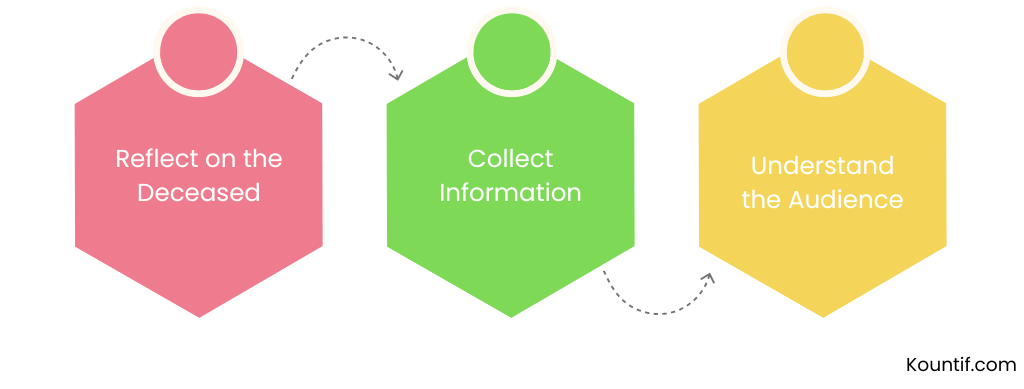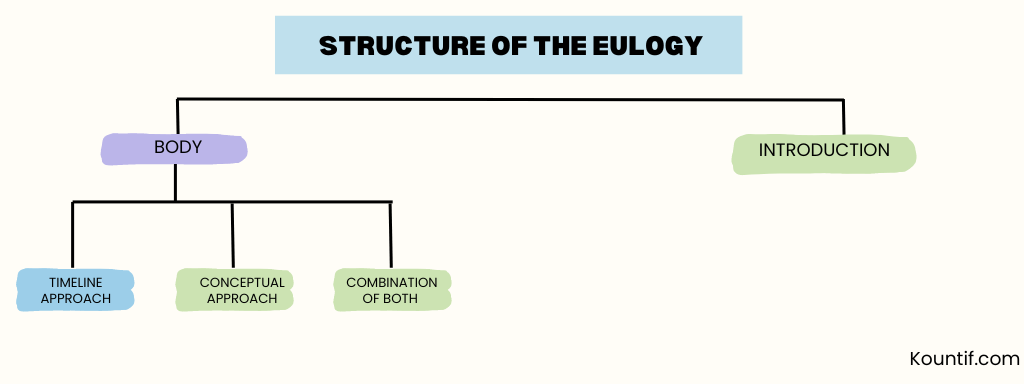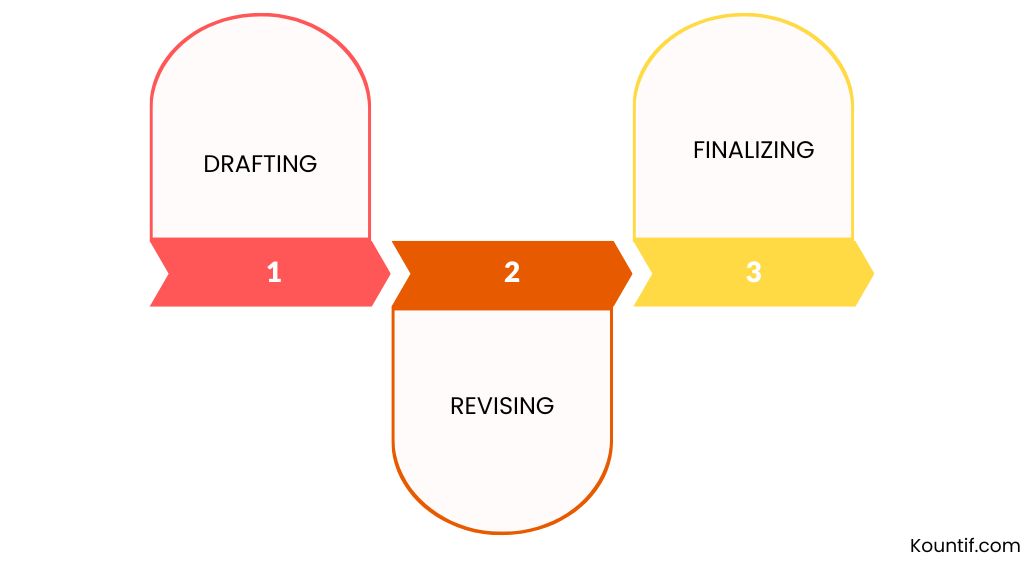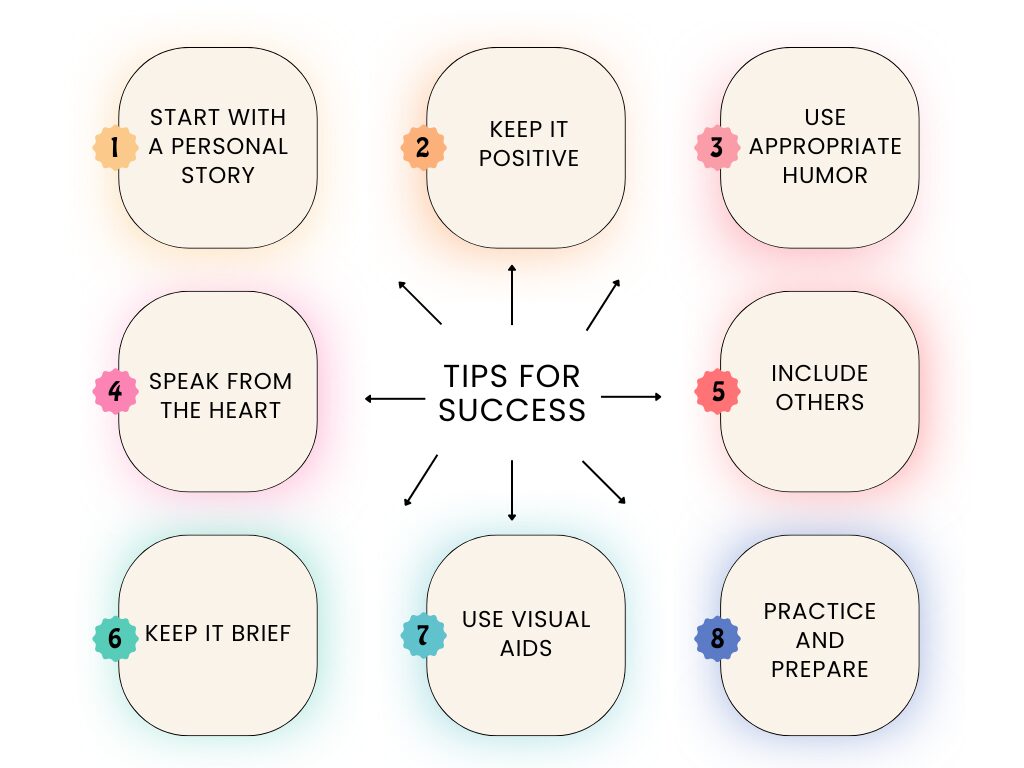
Table of Contents
ToggleIntroduction
Definition of a Eulogy
A eulogy is a memorable speech at a funeral or burial service to honour the deceased person. It’s a tribute that lets sad people think about the life and memory of their loved ones. A close family member or friend usually gives a eulogy that includes personal stories, fond memories, and highlights of the person’s achievements and character. It gives people a chance to meet and remember, which helps those who are mourning and ensures that the death’s effect is recognized and remembered.
Importance of a Eulogy
A well-written speech helps people who are mourning, honours the life of the person who died and brings peace. It brings people together by telling them of memories they share and the way the person who died affected their lives.
Overview of the Process
The process of writing a eulogy involves:
- Gathering information
- Structuring the eulogy
- Writing and refining the speech
- Delivering the eulogy
Preparation
Reflect on the Deceased
Start by thinking about your thoughts and events with the person who died. Think about the critical events, the lessons you learned, and the feelings you had at those times. Talking to family and friends can help you get a wide range of stories and points of view. These talks can show parts of the person’s life and personality that you may not have known before. Learn more about these memories and stories to make your tribute more full and emotional.
Collect Information
Gather important life events, like births, graduations, job changes, and family achievements. Add dates and places important to the story to give it context. Talk about their accomplishments, talents, hobbies, loves, and interests to fully understand their life. Learn about their daily lives, the problems they faced, and how they solved them. Talk about any meaningful relationships they had and how they affected their trip. This will help you tell their life story in a detailed and exciting way.
Think about the audience’s connection to the person who died. Consider whether they were close family members, friends, coworkers, or people you knew. Ensure the topic is acceptable and polite and that it hits home with everyone there. Include personal stories or memories that show the good qualities of the person who died and how they affected the lives of those around them. This will help people feel connected and remember them together.
Structure of the Eulogy
Introduction
Start by saying hello to everyone in the room and telling them about your relationship with the person who has died. Respect the event and send your deepest sympathy to the people there. Summarize the main points in the speech and some examples of the special memories, qualities, and times you will discuss. This beginning will help set the mood and give people an idea of what a meaningful tribute will be like that comes next.
Body
The person’s life story, journey, and accomplishments should be in the body of the speech. Depending on what works best for your story, you can arrange the information by time or by theme. Make great times come to life for the people hearing by using colourful language and storytelling techniques. Include stories, quotes, poems, or songs essential to the deceased. Honour their unique traits, interests, and achievements, and be aware of any problems or difficulties they may have faced.
Timeline Approach
- Early Life and Background: Describe the person’s birthplace, essential childhood memories, and significant difficulties or turning points they experienced during their formative years. Discuss their childhood surroundings, neighbourhood and community, and any significant people or teachers who helped shape their character and beliefs.
- Education and Career: List their intellectual accomplishments, such as the places they went to, the degrees they got, and any awards they won. Talk about their professional journey, including their most important jobs, their accomplishments, and any advances they’ve made in their field. Including stories from their school years, like projects or moments that stood out, and a timeline of their job, focusing on how their skills and hard work led to different wins.
- Family and Personal Life: You can talk about their parents, brothers, partners, and children. Think about their interests, hobbies, relationships, and any volunteer work or community service they were into. Highlight their home life by telling stories showing how they fit into the family and how they affected the people there. Include any routines or activities they did together and discuss how their interests and hobbies improved their lives and those around them.
Conceptual Approach
- Key Characteristics and Values: Bring out the person’s unique qualities and beliefs, highlighting what made them stand out and be remembered. Think about the qualities and values they lived by, like caring, honesty, kindness, giving, and drive, as well as values like ethics. Talk about how they faced the problems in life with grace and drive, leaving an impression on those who knew them.
- Anecdotes and Stories: Include stories and tales that show these qualities. Include special times that show who they were and how they affected other people’s lives. Storytelling about a time when their quick wit made you laugh, or their unwavering support made a difference. Each of these personal stories honours their life and helps everyone remember them clearly.
Combination of Both Approaches
Feel free to mix and match the two approaches, incorporating elements of their life story with anecdotes that exemplify their character. This approach can add depth and variety to the eulogy, creating a more engaging and well-rounded tribute.
Famous Eulogy Quotes
| Quote | Author |
|---|---|
| "The highest tribute to the dead is not grief but gratitude." | Thornton Wilder |
| "Death is not the opposite of life, but a part of it." | Harriet Beecher Stowe |
| "The memories we make with our loved ones are the threads that weave our hearts together." | Anas Bilal |
Writing the Eulogy
Drafting
You are starting with making a detailed sketch based on your chosen structure, making sure to arrange all the main points and supporting details in a way that makes sense. This plan is what you will use to guide your work. Focus on getting your ideas down on paper in the first draft instead of ensuring it’s perfect. This step aims to explore your ideas and provide you with a thorough cover of all the crucial points.
Revising
After writing the first draft, you need to go back and fix everything. Make sure that each line moves into the next one without any problems. Edit for clarity, logic, and simplicity. The tone must stay polite and honest throughout the whole writing. Personal touches and stories will make the material more enjoyable and easy for your audience to relate to. These unique touches make your work stand out and help you connect with the reader.
Finalizing
In the last step, review your draft carefully to find any language or writing mistakes and fix them as needed. This step is crucial for making sure your work is perfect and free of errors that will distract you. Also, I read the words out loud a few times. This can help you find any unusual language or pace problems you might overlook when reading alone. In this way, you can be sure that your delivery is smooth and that your writing has the effect you want on the people who read it.
Delivering the Eulogy
Practice
Practise often in front of a family member or friend you trust who can give you helpful feedback. Make sure you keep track of time to make sure your talk stays on track and try to go at a smooth pace and flow. It would help if you recorded yourself to find ways to improve.
On the Day
Bring a written copy of your talk and a backup, like a digital copy, on your phone or computer if something goes wrong at the last minute. Make sure your audience can easily follow along by speaking properly and slowly. Let your real emotions show to connect with the audience, but have a plan for how to calm down if they get the best of you. Stay calm and focused by learning how to take deep breaths.
Common Mistakes in Writing a Eulogy
| Mistake | Description |
|---|---|
| Focusing too much on grief | Avoid dwelling on sadness and sorrow; focus on celebrating the deceased's life |
| Including too many details | Keep the eulogy concise and focused; avoid unnecessary information |
| Using clichés and overused phrases | Avoid generic phrases and opt for original language and personal anecdotes |
| Failing to proofread | Ensure the eulogy is free of errors and typos |
| Not practicing beforehand | Rehearse the eulogy to feel comfortable with the words and tone |
Tips for Success
Start with a Personal Story:
A personal story about the person who died is one of the most powerful ways to begin a eulogy. This sets the tone for the rest of your speech and helps people feel like they know the person you are honouring. Whatever story you tell can be funny, sad, or just a simple tale that shows what the person was like and how you became close.
Keep it Positive:
Focus on good memories and traits of the person who died, even if it’s hard because of the circumstances. It’s a celebration of their life, so talk about their successes, interests, and how they made others happy. Thinking about these good things can help mourning people and give them peace.
Use Appropriate Humor:
Laughter can help ease stress and connect with the audience in powerful ways. That said, it’s important to use humour that honours the person and doesn’t make fun of them. People will laugh and feel better after hearing a well-placed joke or funny story that they remember. This will make the environment lighter and more like the person who told it.
Speak from the Heart:
Giving a eulogy can be difficult, but the most potent talks are the ones that come from the heart. Please talk about your relationship with the person who died and how they honestly affected your life. Follow your thoughts, and don’t be afraid to be open and honest; this lets other people understand how you feel and share your feelings of loss.
Include Others:
Try to include other people in your speech by telling memories or stories that involve more than one person. This can help make the speech feel like a group discussion where everyone has a shared experience. Identifying how the dead affected various people’s lives can help paint a better picture of their personality and influence, bringing attention to their wide range of effects.
Keep it Brief:
A speech should be between 5 and 10 minutes long, so it’s essential to keep your words short and to the point. Do this to keep your feelings in check and get your point across clearly. By breaking your ideas down into key points, you can ensure that your speech is powerful, remembered, and manageable for the audience.
Use Visual Aids:
If it makes sense, use pictures or movies to help make your points and bring the person’s life to life for the audience. Visual tools can bring up memories and feelings that words alone might not be able to express. This can help people feel more connected to and understand the life and impact of the person who has died.
Practice and Prepare:
Even though practising giving a eulogy might be hard on the emotions, doing so can help calm your nerves and ensure you provide a moving speech. Practising with a trusted friend or in front of a mirror can help you improve and boost your confidence.
Overview
| Step | Description | Tips and Considerations |
|---|---|---|
| Gather Information | Collect memories, stories, and achievements of the deceased | Talk to family and friends, review photos and mementos, consider the deceased's personality and accomplishments |
| Define the Tone | Determine the tone of the eulogy (e.g. solemn, celebratory, humorous) | Consider the personality of the deceased and the audience, be respectful and sincere |
| Structure the Eulogy | Organize the information into a coherent speech | Use a timeline or conceptual approach, include an introduction and conclusion, consider using a theme or central message |
| Write the Eulogy | Draft and revise the speech | Focus on the positive, use appropriate humor, speak from the heart, use storytelling techniques, be concise and clear |
| Deliver the Eulogy | Practice and prepare for the delivery | Practice several times, pace yourself, make eye contact, use visual aids, be mindful of the audience and the occasion |
Conclusion
Writing a eulogy is a challenging but meaningful task honouring a loved one’s life and legacy. This process lets you reflect on their journey, achievements, and impact. Following the steps in this guide, you can craft a heartfelt tribute that celebrates their life, shares their story, and comforts those grieving. Speak from the heart, using personal anecdotes and cherished memories. Keep the tone positive, focusing on the joy and love they brought, and use appropriate humour to bring smiles. This balance will make the eulogy a fitting tribute, ensuring their memory lives on in the minds and hearts of everyone present.
FAQs
What is a eulogy?
A eulogy is a memorable speech at a funeral or burial service to honour the deceased person. It’s a tribute that lets sad people think about the life and memory of their loved ones.
How long should a eulogy be?
A eulogy should be between 5 to 10 minutes long. This length allows you to share your thoughts and memories without overwhelming the audience.
What should I include in a eulogy?
You should include personal stories, fond memories, and highlights of the person’s achievements and character. You can also include quotes, poems, or songs essential to the deceased.
How can I make my eulogy more engaging?
You can make your eulogy more engaging by using visual aids like pictures or videos, speaking from the heart, and using appropriate humour. You can also include others in your speech by telling memories or stories that involve more than one person.







